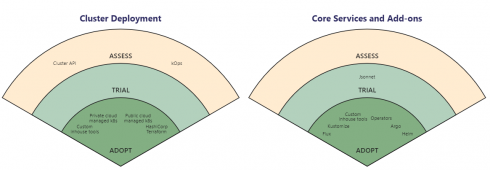
The Cloud Native Computing Foundation (CNCF) is trying to make it easier for companies to choose a multicluster management solution for their environments with the release of its fifth CNCF End User Technology Radar. The radar is a guide to emerging technologies that are chosen based on feedback from the CNCF End User Community.
According to the CNCF, distributed and multi-cloud deployments have benefits like improved availability, reduced latency, and scalability, but also increases complexity because each cluster has to be individually deployed and managed.
The CNCF End User Technology Radar for multicluster management is divided into two categories: 1) cluster deployment, and 2) core services and add-ons. This is intended to differentiate between tools used for deployment and management. Each sub-category is further divided into tools to Adopt, Trial, or Assess.
In the cluster deployment subcategory, tools recommended to be adopted include custom inhouse tools, private cloud managed k8s, public cloud managed k8s, and HashiCorp Terraform. Tools to assess include Cluster API and kOps.
In the core services and add-ons category, tools to adopt include Flux, Kustomize, custom inhouse tools, Operators, Argo, and Helm. Jsonnet was listed as a tool to trial.
According to the CNCF there were five key themes to the rader:
- There isn’t a silver bullet tool for multicluster management
- Custom inhouse solutions are often needed
- Common tool combinations are Helm with Operators/GitOps
- Operators are a favorite tool
- The community is eagerly awaiting Cluster API to be ready
“Multicluster management is still an emerging and complex space, so we wanted to gain a broader understanding of how organizations are doing it in the real world,” said Cheryl Hung, VP of ecosystem at the CNCF. “What we found is that there is no one size fits all solution for cluster management. Overall, approaches vary widely based on the number of clusters deployed and the management tools already in place, and custom tooling is usually necessary.”








